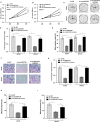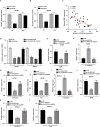CircAGFG1 Promotes Ovarian Cancer Progression Through the miR-409-3 p/ZEB1 Axis
- PMID: 38752261
- PMCID: PMC11102704
- DOI: 10.1177/15330338241252423
CircAGFG1 Promotes Ovarian Cancer Progression Through the miR-409-3 p/ZEB1 Axis
Abstract
Objectives: Circular RNAs (circRNAs) serve a crucial regulatory role in ovarian cancer (OC). Circular RNA ArfGAP with FG repeats 1 (circAGFG1) has been shown to be involved in promoting the progression of several cancers, containing triple-negative breast cancer, esophageal cancer and colorectal cancer. However, the function of circAGFG1 in OC is unclear.
Methods: Quantitative real-time reverse transcription PCR (RT-qPCR) was conducted to determine the expression levels of circAGFG1 and miR-409-3p. The proliferation and metastasis of cells were determined by colony formation assays, EdU assays, transwell assays and wound healing assays. In addition, a dual-luciferase reporter assay was performed to validate the mechanism between circAGFG1, miR-409-3p, and ZEB1.
Results: Our data suggested that circAGFG1 was significantly overexpressed in OC tissues compared to normal ovarian epithelial tissues. Overexpression of circAGFG1 was correlated with intraperitoneal metastasis, tumor recurrence and advanced stage. Additionally, circAGFG1 overexpression revealed a poor prognosis in OC patients. Knockdown of circAGFG1 suppressed the proliferation, invasion and migration of OC cells. Mechanistically, circAGFG1 acted as a sponge of miR-409-3p to enhance the expression level of zinc finger E-box binding homeobox 1 (ZEB1), thereby conferring OC cell proliferation, invasion and migration. Importantly, re-expression of ZEB1 effectively reversed the effects of circAGFG1 knockdown on OC cells.
Conclusions: In summary, our study indicated that circAGFG1 may act as a prognostic biomarker and potential therapeutic target for patients with OC.
Keywords: ZEB1; circAGFG1; miR-409-3p; ovarian cancer; progression.
Conflict of interest statement
Declaration of Conflicting InterestsThe authors declared no potential conflicts of interest with respect to the research, authorship, and/or publication of this article.
Figures




Similar articles
-
Hsa_circ_0005571 promotes the proliferation and invasion of colorectal cancer cells.Sci Rep. 2025 Aug 22;15(1):30931. doi: 10.1038/s41598-025-16450-2. Sci Rep. 2025. PMID: 40846892 Free PMC article.
-
miR-429 suppresses progression and metastasis of salivary adenoid cystic carcinoma by targeting ZEB1.J Mol Histol. 2025 Jul 9;56(4):224. doi: 10.1007/s10735-025-10504-5. J Mol Histol. 2025. PMID: 40632321
-
Long non-coding RNA PVT1 promotes cell proliferation and invasion through regulating miR-133a in ovarian cancer.Biomed Pharmacother. 2018 Oct;106:61-67. doi: 10.1016/j.biopha.2018.06.112. Epub 2018 Jun 26. Biomed Pharmacother. 2018. Retraction in: Biomed Pharmacother. 2025 Aug 15:118383. doi: 10.1016/j.biopha.2025.118383. PMID: 29957467 Retracted.
-
The emerging roles and potential applications of circular RNAs in ovarian cancer: a comprehensive review.J Cancer Res Clin Oncol. 2023 May;149(5):2211-2234. doi: 10.1007/s00432-022-04328-z. Epub 2022 Sep 2. J Cancer Res Clin Oncol. 2023. PMID: 36053324 Free PMC article. Review.
-
Role of circular RNA as competing endogenous RNA in ovarian cancer (Review).Int J Mol Med. 2024 May;53(5):41. doi: 10.3892/ijmm.2024.5365. Epub 2024 Mar 8. Int J Mol Med. 2024. PMID: 38456562 Free PMC article. Review.
Cited by
-
Prognostic significance of non-coding RNAs related to the tumorigenic epithelial-mesenchymal transition (EMT) process among ovarian cancer patients: A systematic review and meta-analysis.Heliyon. 2024 Aug 8;10(16):e35202. doi: 10.1016/j.heliyon.2024.e35202. eCollection 2024 Aug 30. Heliyon. 2024. PMID: 39253159 Free PMC article.
-
Circular RNAs in cancer stem cells: Insights into their roles and mechanisms (Review).Int J Mol Med. 2025 Mar;55(3):50. doi: 10.3892/ijmm.2025.5491. Epub 2025 Jan 24. Int J Mol Med. 2025. PMID: 39930823 Free PMC article. Review.
-
The Dual Roles of Circular RNAs in Breast Cancer Distant Metastasis and Their Clinical Applications.J Cancer. 2025 Jul 11;16(10):3270-3282. doi: 10.7150/jca.111680. eCollection 2025. J Cancer. 2025. PMID: 40740236 Free PMC article. Review.
References
-
- Siegel RL, Miller KD, Fuchs HE, Jemal A. Cancer statistics, 2022. CA Cancer J Clin. 2022;72(1):7-33. - PubMed
-
- Roett MA, Evans P. Ovarian cancer: an overview. Am Fam Physician 2009;80(6):609-616. - PubMed
-
- Shirvani H, Ghanavi J, Aliabadi A, et al. MiR-211 plays a dual role in cancer development: from tumor suppressor to tumor enhancer. Cell Signal. 2023;101:110504. - PubMed
-
- Pordel S, Khorrami M, Saadatpour F, et al. The role of microRNA-185 in the pathogenesis of human diseases: a focus on cancer. Pathol Res Pract. 2023;249:154729. - PubMed
MeSH terms
Substances
LinkOut - more resources
Full Text Sources
Medical
Molecular Biology Databases
Research Materials

